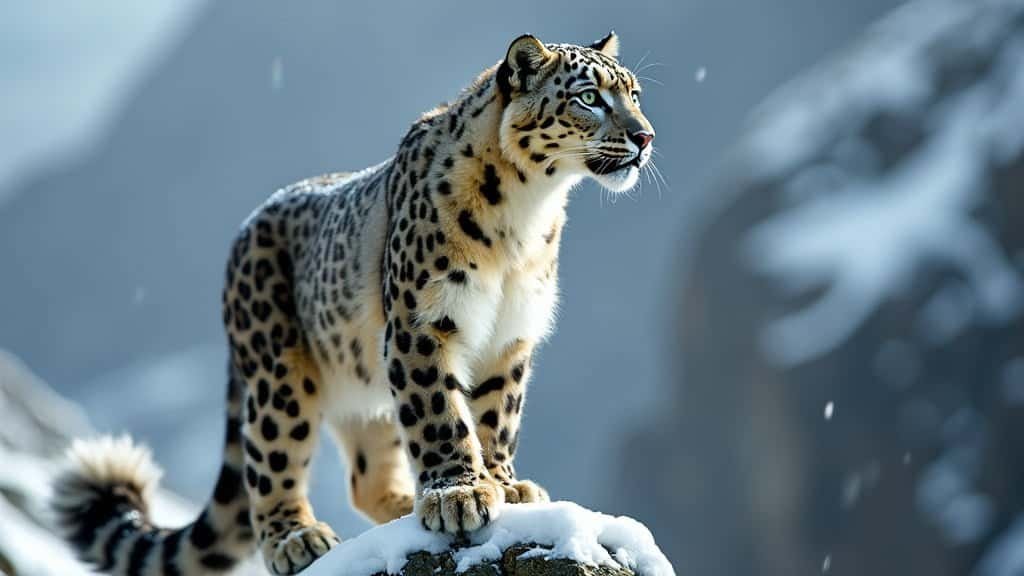Introduction
The Global Snow Leopard and Ecosystem Protection Program (GSLEP) is an ambitious international initiative aimed at preserving the endangered snow leopard and its natural habitat. This article delves into the primary objectives of GSLEP, focusing on its conservation goals, community engagement, international collaborations, and the challenges it faces
We will explore how GSLEP works to protect snow leopards, safeguard ecosystems, and promote biodiversity, while also highlighting the program’s successes and ongoing efforts in sustainable conservation
Conservation Goals of GSLEP
The Global Snow Leopard and Ecosystem Protection Program (GSLEP) has set forth ambitious conservation goals to ensure the survival of the snow leopard, an iconic species of the high mountain ecosystems of Central and South Asia
These objectives are not just about preserving a single species but also about maintaining the ecological integrity of the regions where these elusive cats roam. The program’s goals are comprehensive, targeting both direct conservation actions and broader environmental stewardship
Protecting Snow Leopard Populations
One of the core objectives of GSLEP is to stabilize and increase snow leopard populations across their natural range, which spans 12 countries in Asia, including India, China, Mongolia, and Russia
According to the World Wildlife Fund (WWF), there are an estimated 4,000 to 6,500 snow leopards left in the wild, but exact numbers are challenging to determine due to the species’ elusive nature and vast, rugged habitats
GSLEP aims to protect these populations through anti-poaching measures, strict law enforcement, and enhanced patrolling in protected areas. By working closely with local governments and communities, GSLEP helps establish and manage protected areas and wildlife corridors that are crucial for the snow leopard’s survival
The program also emphasizes the need for continuous monitoring and research, employing technologies like camera traps and GPS tracking to gather data on snow leopard movements, population densities, and health
Safeguarding Ecosystems
Another key objective of GSLEP is the protection of the ecosystems that snow leopards depend on. Snow leopards inhabit some of the most fragile and remote mountain ecosystems on Earth, such as the Himalayas and the Pamirs
These regions are not only critical for biodiversity but also provide essential services, such as water resources, to millions of people downstream
GSLEP’s approach to ecosystem protection is holistic, aiming to preserve the integrity of entire landscapes rather than isolated patches of habitat. This involves promoting sustainable land-use practices, preventing habitat fragmentation, and restoring degraded areas
The program collaborates with local and national governments to integrate conservation efforts into broader land management and development plans. Moreover, GSLEP emphasizes the importance of conserving prey species, such as blue sheep and ibex, which are vital for the snow leopard’s diet
Promoting Biodiversity
In addition to focusing on snow leopards, GSLEP’s objectives include broader goals related to promoting biodiversity across the landscapes it targets
Snow leopards are considered an “umbrella species,” meaning that their conservation helps protect a wide range of other species that share their habitat. By safeguarding snow leopard habitats, GSLEP also contributes to the preservation of various plant and animal species that are part of these complex ecosystems
GSLEP’s biodiversity promotion efforts are aligned with global conservation goals, such as those outlined by the Convention on Biological Diversity (CBD). These efforts include initiatives to combat climate change, prevent deforestation, and promote reforestation in critical areas
GSLEP also works to raise awareness about the importance of biodiversity and ecosystem services, highlighting how conserving snow leopards and their habitats benefits not just wildlife but also human communities
The program’s multifaceted approach to conservation recognizes that the survival of snow leopards is intricately linked to the health of entire ecosystems. By setting clear, actionable goals in protecting both the species and its environment, GSLEP serves as a model for integrated conservation efforts that address the needs of both wildlife and people
Community Engagement in GSLEP
The Global Snow Leopard and Ecosystem Protection Program (GSLEP) recognizes that the success of conservation efforts largely depends on the involvement and support of local communities
Snow leopards inhabit vast areas that are often home to indigenous peoples and pastoralist communities whose livelihoods are closely tied to these landscapes
Therefore, community engagement is a cornerstone of GSLEP’s strategy, aiming to foster a collaborative approach where conservation goals align with the socio-economic interests of local populations
Involvement of Local Communities
GSLEP places a strong emphasis on involving local communities in conservation activities, ensuring they play an active role in protecting snow leopards and their habitats
The program promotes the idea that local people, who are most familiar with the land and wildlife, are crucial partners in conservation. By empowering these communities, GSLEP aims to create a sense of ownership and responsibility towards conservation efforts
One of the key initiatives under this objective is the establishment of community-managed conservation areas. These areas are designated and managed by local communities with guidance and support from GSLEP and its partners
The success of these initiatives is evident in regions like the Spiti Valley in India, where local communities have successfully protected snow leopards by setting up livestock insurance programs and predator-proof corrals to prevent conflicts between snow leopards and herders
Additionally, GSLEP supports the formation of community-based anti-poaching units. These units are composed of local volunteers trained to monitor wildlife, report illegal activities, and promote awareness about the importance of protecting snow leopards
By involving communities in these critical tasks, GSLEP not only enhances the effectiveness of conservation efforts but also builds trust and cooperation between local people and conservation authorities
Education and Awareness Programs
Education is another vital component of GSLEP’s community engagement strategy. The program implements a range of education and awareness programs aimed at increasing knowledge about snow leopards and the importance of conserving their ecosystems
These programs target different segments of the community, including school children, women’s groups, and local leaders
Educational initiatives often include workshops, school visits, and the distribution of educational materials that highlight the ecological role of snow leopards and the benefits of biodiversity conservation
In some regions, GSLEP partners with local schools to incorporate conservation education into the curriculum, ensuring that the next generation is informed and motivated to participate in conservation efforts
Awareness campaigns are also crucial in changing perceptions about snow leopards. In many areas, snow leopards have been viewed as a threat to livestock and, consequently, to the livelihoods of herders. GSLEP works to shift this narrative by emphasizing the ecological importance of snow leopards and the potential for coexisting with these predators
Through community meetings, media campaigns, and storytelling, GSLEP fosters a more positive attitude towards snow leopards, reducing human-wildlife conflict and garnering broader support for conservation
Sustainable Livelihood Initiatives
To ensure that conservation efforts are sustainable in the long term, GSLEP also focuses on improving the livelihoods of local communities
The program recognizes that poverty and lack of economic opportunities can drive activities that threaten snow leopards and their habitats, such as poaching, illegal logging, and overgrazing. Therefore, GSLEP promotes alternative livelihood options that are compatible with conservation goals
One of the key strategies is the development of eco-friendly tourism, which allows communities to benefit financially from the presence of snow leopards. Community-managed homestays, guided wildlife tours, and the sale of local handicrafts are some of the ways in which GSLEP helps communities generate income while promoting conservation
These initiatives not only reduce the economic pressures that can lead to environmental degradation but also provide an incentive for communities to protect snow leopards and their habitats
Another initiative is the support of sustainable agriculture and livestock management practices. GSLEP works with communities to implement techniques that reduce overgrazing and land degradation, such as rotational grazing and the use of fodder crops
These practices help maintain healthy ecosystems while also improving the productivity and resilience of local agriculture, thus securing food and income for local people
By integrating community engagement into its conservation strategy, GSLEP ensures that its efforts are not only effective but also equitable. The program’s initiatives empower local communities, provide them with economic opportunities, and foster a cooperative approach to conservation that benefits both people and wildlife
International Collaboration and Partnerships
The Global Snow Leopard and Ecosystem Protection Program (GSLEP) is a testament to the power of international collaboration in addressing conservation challenges that cross national boundaries
Snow leopards inhabit a range that spans 12 countries, making it essential for these nations to work together towards a common goal. GSLEP fosters this collaboration through strategic partnerships, shared resources, and coordinated efforts that enhance the effectiveness of conservation actions across the snow leopard’s range
Countries Participating in GSLEP
GSLEP is a unique initiative that brings together 12 range countries, each of which plays a vital role in the conservation of snow leopards and their habitats
These countries include Afghanistan, Bhutan, China, India, Kazakhstan, Kyrgyzstan, Mongolia, Nepal, Pakistan, Russia, Tajikistan, and Uzbekistan. Each of these nations contributes to GSLEP by implementing national conservation strategies that align with the program’s overarching goals
The program encourages these countries to develop and adhere to National Snow Leopard and Ecosystem Protection Priorities (NSLEP), which are tailored to the specific ecological, social, and economic conditions of each nation
These priorities include actions such as creating protected areas, improving law enforcement, and engaging local communities. By aligning these national efforts with the broader goals of GSLEP, the program ensures a cohesive and coordinated approach to snow leopard conservation across borders
Furthermore, GSLEP facilitates regular meetings and workshops where representatives from the range countries can share experiences, discuss challenges, and coordinate strategies
These gatherings help build trust and cooperation among the countries, fostering a sense of shared responsibility for the conservation of snow leopards and their ecosystems
Partner Organizations
In addition to the range countries, GSLEP collaborates with a variety of international and non-governmental organizations (NGOs) that bring expertise, resources, and global reach to the program
Key partners include the World Wildlife Fund (WWF), the Snow Leopard Trust, the United Nations Development Programme (UNDP), and the Global Environment Facility (GEF). These organizations provide technical support, funding, and capacity-building services that are crucial for the successful implementation of GSLEP’s initiatives
For example, the Snow Leopard Trust, a key partner of GSLEP, has been instrumental in research and monitoring efforts, providing essential data on snow leopard populations, behavior, and habitats
The WWF collaborates with GSLEP on a range of activities, from anti-poaching initiatives to community engagement programs. UNDP and GEF play a significant role in securing funding for large-scale conservation projects and facilitating international cooperation
GSLEP also engages with academic institutions and research organizations to advance scientific knowledge about snow leopards and their ecosystems. These partnerships enable the program to apply the latest research findings to its conservation strategies, ensuring that actions are based on sound science and best practices
Funding and Resources
Securing adequate funding and resources is critical to the success of GSLEP. The program relies on a combination of international grants, government contributions, and private donations to fund its conservation activities
One of the major sources of funding for GSLEP is the Global Environment Facility (GEF), which has provided significant financial support for the implementation of conservation projects across the snow leopard range
In addition to GEF funding, GSLEP receives financial and in-kind support from various governments, NGOs, and private donors. These resources are allocated to key areas such as habitat protection, anti-poaching measures, community engagement, and research
GSLEP’s ability to mobilize resources from diverse sources is a testament to the broad support for snow leopard conservation and the program’s effectiveness in leveraging partnerships
Moreover, GSLEP has established a framework for resource-sharing among participating countries. This framework facilitates the exchange of expertise, technology, and best practices, ensuring that all countries, regardless of their economic status, can benefit from the latest advances in conservation
For instance, wealthier nations like China and Russia often provide technical assistance and training to other range countries, helping to build local capacity and enhance the overall impact of the program
GSLEP’s focus on international collaboration and partnerships underscores the importance of a unified, global approach to conservation. By bringing together diverse stakeholders from around the world, GSLEP enhances the effectiveness of its efforts, ensuring that snow leopards and their ecosystems are protected for future generations
Challenges and Successes of GSLEP
The Global Snow Leopard and Ecosystem Protection Program (GSLEP) faces a complex array of challenges in its mission to conserve snow leopards and their habitats across 12 countries
These challenges range from combating poaching and illegal wildlife trade to addressing habitat fragmentation and the impacts of climate change. However, despite these hurdles, GSLEP has also achieved significant successes that highlight the program’s effectiveness and the potential for long-term conservation outcomes
Addressing Poaching and Illegal Trade
One of the most significant challenges GSLEP encounters is the persistent threat of poaching and illegal wildlife trade. Snow leopards are targeted for their pelts, bones, and other body parts, which are highly valued in illegal markets, particularly in Asia
The demand for snow leopard parts, driven by traditional medicine practices and luxury markets, poses a serious threat to the survival of the species
GSLEP has implemented a range of strategies to combat poaching and illegal trade, including enhancing law enforcement, increasing patrols in protected areas, and supporting community-based anti-poaching units. These efforts are critical in deterring poachers and disrupting illegal trade networks
Moreover, GSLEP works closely with international organizations like INTERPOL and CITES (Convention on International Trade in Endangered Species of Wild Fauna and Flora) to strengthen cross-border cooperation in tracking and prosecuting wildlife criminals
Despite these efforts, poaching remains a significant challenge, particularly in remote and hard-to-monitor areas. However, GSLEP’s ongoing efforts have led to a decrease in poaching incidents in some regions, and the program continues to innovate and adapt its strategies to stay ahead of poachers
Overcoming Habitat Fragmentation
Habitat fragmentation is another major challenge that threatens the survival of snow leopards. As human populations expand and develop land for agriculture, infrastructure, and settlements, snow leopard habitats become increasingly fragmented
This fragmentation not only reduces the available space for snow leopards to roam but also isolates populations, leading to decreased genetic diversity and increased vulnerability to extinction
GSLEP addresses habitat fragmentation through landscape-level conservation planning, which focuses on maintaining and restoring habitat connectivity across large areas
This approach involves creating wildlife corridors that link isolated habitats, allowing snow leopards to move freely between them. These corridors are essential for the long-term survival of snow leopards, as they ensure access to prey, breeding opportunities, and refuge from human activities
In addition to creating corridors, GSLEP promotes sustainable land-use practices that minimize the impact of human activities on snow leopard habitats. For example, the program works with local communities to implement rotational grazing systems that reduce overgrazing and prevent land degradation
GSLEP also collaborates with governments and developers to plan infrastructure projects, such as roads and dams, in a way that minimizes habitat disruption
While habitat fragmentation remains a significant challenge, GSLEP’s efforts to mitigate its effects have been successful in several regions. The establishment of transboundary protected areas, where countries collaborate to manage and conserve shared habitats, is one of the program’s key achievements in addressing this issue
Success Stories and Achievements
Despite the numerous challenges, GSLEP has achieved several notable successes that demonstrate the program’s impact and potential for long-term conservation
One of the most significant achievements is the increase in snow leopard populations in certain key areas. For instance, in Mongolia’s Tost Mountains, concerted conservation efforts led by GSLEP and its partners have resulted in a stable and even growing snow leopard population, as documented by extensive camera trap surveys
Another success story is the establishment of the first-ever Global Snow Leopard & Ecosystem Protection (GSLEP) Forum, held in 2013 in Bishkek, Kyrgyzstan
This historic event brought together leaders from all 12 snow leopard range countries, along with international conservation organizations, to commit to a coordinated approach to snow leopard conservation. The forum resulted in the adoption of the Bishkek Declaration, a landmark agreement that set the stage for the collaborative efforts that define GSLEP today
GSLEP has also made significant strides in community engagement, particularly in promoting sustainable livelihoods that align with conservation goals. In many regions, eco-tourism initiatives have provided communities with alternative income sources while fostering a greater appreciation for snow leopards and their habitats
These initiatives have not only improved the economic well-being of local people but have also contributed to a reduction in human-wildlife conflict, as communities are now more invested in the protection of snow leopards
Additionally, GSLEP’s focus on scientific research and monitoring has yielded valuable data that inform conservation strategies. The program’s use of modern technologies, such as GPS collars and camera traps, has significantly enhanced our understanding of snow leopard behavior, population dynamics, and habitat use. This data is crucial for making informed decisions about conservation actions and for measuring the success of the program’s initiatives
Conclusion
The Global Snow Leopard and Ecosystem Protection Program (GSLEP) represents a groundbreaking effort in international conservation, focusing on the survival of snow leopards and the preservation of their vast, mountainous habitats
Through its comprehensive objectives, GSLEP works to stabilize snow leopard populations, protect vital ecosystems, and promote biodiversity across the species’ range. The program’s success hinges on its ability to engage local communities, providing them with sustainable livelihoods and education, which foster a collaborative approach to conservation
International collaboration is another cornerstone of GSLEP, bringing together 12 countries and numerous partner organizations in a unified effort. Despite facing significant challenges such as poaching, illegal trade, and habitat fragmentation, GSLEP has achieved notable successes, including increased snow leopard populations in key areas and the establishment of protected corridors that maintain habitat connectivity
These accomplishments highlight the program’s potential for long-term impact, demonstrating that with continued effort and cooperation, the conservation of snow leopards and their ecosystems is an achievable goal







